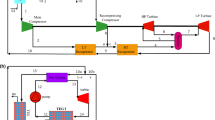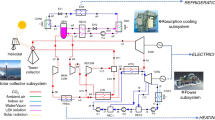Abstract
Energy consumption growth in the world is one of the primary concerns of researchers in the energy fields. Providing demanded power, especially in peak consumption times besides less emission production, is always been the goal of power plants designers. Utilizing auxiliary devices or cycles such as compressed air energy system or organic Rankine cycle can help them to achieve their goal. However, the performance of these auxiliary instruments should be evaluated having the best design achieving the target. In this research, employing compressed air energy besides utilizing an organic Rankine cycle is proposed for improving the performance of a Brayton power cycle; moreover, optimum operating condition for compression ratio of each cycle is found with energy–exergy analysis. Various working fluids for organic Rankine cycle are explored, and the best conditions are introduced based on energy and exergy parameters, namely the first- and second-law efficiencies, power and exergy destruction. Results show that the optimum compression ratio of Brayton cycle is 7.5 for all considered organic fluids, and optimum pressure ratio of organic Rankine cycle is 5.5 for isopentane and n-pentane. Isopentane has the least exergy destruction, while the maximum first- and second-law efficiencies are achieved by R123.








Similar content being viewed by others
References
Gruenspecht H. International energy outlook 2011. Center for Strategic and International Studies. 2010.
Abdollahzadeh Jamalabadi MY, Ghasemi M, Alamian R, Afshari E, Wongwises S, Rashidi MM, Safdari Shadloo M. A 3D simulation of single-channel high-temperature polymer exchange membrane fuel cell performances. Appl Sci. 2019;9:3633.
Atyabi SA, Afshari E, Wongwises S, Yan W-M, Hadjadj A, Shadloo MS. Effects of assembly pressure on PEM fuel cell performance by taking into accounts electrical and thermal contact resistances. Energy. 2019;179:490–501.
Toghyani S, Fakhradini S, Afshari E, Baniasadi E, Jamalabadi MYA, Shadloo MS. Optimization of operating parameters of a polymer exchange membrane electrolyzer. Int J Hydrog Energy. 2019;44:6403–14.
Alamian R, Shafaghat R, Safaei MR. Multi-objective optimization of a pitch point absorber wave energy converter. Water. 2019;11:969.
Alamian R, Shafaghat R, Shadloo MS, Bayani R, Amouei AH. An empirical evaluation of the sea depth effects for various wave characteristics on the performance of a point absorber wave energy converter. Ocean Eng. 2017;137:13–21.
Zanous SP, Shafaghat R, Alamian R, Shadloo MS, Khosravi M. Feasibility study of wave energy harvesting along the southern coast and islands of Iran. Renew Energy. 2019;135:502–14.
Alamian R, Shafaghat R, Bayani R, Amouei AH. An experimental evaluation of the effects of sea depth, wave energy converter’s draft and position of centre of gravity on the performance of a point absorber wave energy converter. J Mar Eng Technol. 2017;16:70–83.
Amiri HA, Shafaghat R, Alamian R, Taheri SM, Shadloo MS. Study of horizontal axis tidal turbine performance and investigation on the optimum fixed pitch angle using CFD. Int J Numer Methods Heat Fluid Flow. 2019; vol. ahead-of-print no. ahead-of-print. https://doi.org/10.1108/HFF-05-2019-0447, doi:vol. ahead-of-print No. ahead-of-print. https://doi.org/10.1108/HFF-05-2019-0447.
Ebrahimpour M, Shafaghat R, Alamian R, Safdari Shadloo M. Numerical investigation of the savonius vertical axis wind turbine and evaluation of the effect of the overlap parameter in both horizontal and vertical directions on its performance. Symmetry. 2019;11:821.
Toghyani S, Afshari E, Baniasadi E, Shadloo M. Energy and exergy analyses of a nanofluid based solar cooling and hydrogen production combined system. Renew Energy. 2019;141:1013–25.
Ahmadi P, Dincer I, Rosen MA. Exergo-environmental analysis of an integrated organic Rankine cycle for trigeneration. Energy Convers Manag. 2012;64:447–53.
Akbari AD, Mahmoudi SM. Thermoeconomic analysis and optimization of the combined supercritical CO2 (carbon dioxide) recompression Brayton/organic Rankine cycle. Energy. 2014;78:501–12.
Cheng K, Qin J, Dang C, Lv C, Zhang S, Bao W. Thermodynamic analysis for high-power electricity generation systems based on closed-Brayton-cycle with finite cold source on hypersonic vehicles. Int J Hydrog Energy. 2018;43:14762–74.
Ahmadi MH, Ahmadi M-A, Pourfayaz F, Bidi M. Thermodynamic analysis and optimization for an irreversible heat pump working on reversed Brayton cycle. Energy Convers Manag. 2016;110:260–7.
Kouta A, Al-Sulaiman F, Atif M, Marshad SB. Entropy, exergy, and cost analyses of solar driven cogeneration systems using supercritical CO2 Brayton cycles and MEE-TVC desalination system. Energy Convers Manag. 2016;115:253–64.
Li L, Mu H, Gao W, Li M. Optimization and analysis of CCHP system based on energy loads coupling of residential and office buildings. Appl Energy. 2014;136:206–16.
Ortiz C, Chacartegui R, Valverde J, Alovisio A, Becerra J. Power cycles integration in concentrated solar power plants with energy storage based on calcium looping. Energy Convers Manag. 2017;149:815–29.
Singh OK, Kaushik S. Thermoeconomic evaluation and optimization of a Brayton–Rankine–Kalina combined triple power cycle. Energy Convers Manag. 2013;71:32–42.
Zare V, Hasanzadeh M. Energy and exergy analysis of a closed Brayton cycle-based combined cycle for solar power tower plants. Energy Convers Manag. 2016;128:227–37.
Zare V, Moalemian A. Parabolic trough solar collectors integrated with a Kalina cycle for high temperature applications: energy, exergy and economic analyses. Energy Convers Manag. 2017;151:681–92.
Chen L-X, Hu P, Sheng C-C, Xie M-N. A novel compressed air energy storage (CAES) system combined with pre-cooler and using low grade waste heat as heat source. Energy. 2017;131:259–66.
Kim Y, Favrat D. Energy and exergy analysis of a micro-compressed air energy storage and air cycle heating and cooling system. Energy. 2010;35:213–20.
Shadloo M, Poultangari R, Jamalabadi MA, Rashidi M. A new and efficient mechanism for spark ignition engines. Energy Convers Manag. 2015;96:418–29.
Lund H, Salgi G. The role of compressed air energy storage (CAES) in future sustainable energy systems. Energy Convers Manag. 2009;50:1172–9.
Lv S, He W, Zhang A, Li G, Luo B, Liu X. Modelling and analysis of a novel compressed air energy storage system for trigeneration based on electrical energy peak load shifting. Energy Convers Manag. 2017;135:394–401.
Ji W, Zhou Y, Sun Y, Zhang W, An B, Wang J. Thermodynamic analysis of a novel hybrid wind-solar-compressed air energy storage system. Energy Convers Manag. 2017;142:176–87.
Mohammadi A, Ahmadi MH, Bidi M, Joda F, Valero A, Uson S. Exergy analysis of a combined cooling, heating and power system integrated with wind turbine and compressed air energy storage system. Energy Convers Manag. 2017;131:69–78.
Yao E, Wang H, Wang L, Xi G, Maréchal F. Multi-objective optimization and exergoeconomic analysis of a combined cooling, heating and power based compressed air energy storage system. Energy Convers Manag. 2017;138:199–209.
Khaljani M, Saray RK, Bahlouli K. Comprehensive analysis of energy, exergy and exergo-economic of cogeneration of heat and power in a combined gas turbine and organic Rankine cycle. Energy Convers Manag. 2015;97:154–65.
Sun W, Yue X, Wang Y. Exergy efficiency analysis of ORC (organic Rankine cycle) and ORC-based combined cycles driven by low-temperature waste heat. Energy Convers Manag. 2017;135:63–73.
Kaşka Ö. Energy and exergy analysis of an organic Rankine for power generation from waste heat recovery in steel industry. Energy Convers Manag. 2014;77:108–17.
Lecompte S, Ameel B, Ziviani D, van den Broek M, De Paepe M. Exergy analysis of zeotropic mixtures as working fluids in organic Rankine cycles. Energy Convers Manag. 2014;85:727–39.
Karellas S, Braimakis K. Energy–exergy analysis and economic investigation of a cogeneration and trigeneration ORC–VCC hybrid system utilizing biomass fuel and solar power. Energy Convers Manag. 2016;107:103–13.
Bao J, Zhao L. A review of working fluid and expander selections for organic Rankine cycle. Renew Sustain Energy Rev. 2013;24:325–42.
Chen Y, Lundqvist P, Johansson A, Platell P. A comparative study of the carbon dioxide transcritical power cycle compared with an organic Rankine cycle with R123 as working fluid in waste heat recovery. Appl Therm Eng. 2006;26:2142–7.
Mago PJ, Chamra LM, Srinivasan K, Somayaji C. An examination of regenerative organic Rankine cycles using dry fluids. Appl Therm Eng. 2008;28:998–1007.
Ghim G, Lee J. Experimental evaluation of the in-tube condensation heat transfer of pure n-pentane/R245fa and their non-azeotropic mixture as an ORC working fluid. Appl Therm Eng. 2016;106:753–61.
Wang X, Dai Y. Exergoeconomic analysis of utilizing the transcritical CO2 cycle and the ORC for a recompression supercritical CO2 cycle waste heat recovery: a comparative study. Appl Energy. 2016;170:193–207.
Nouri M, Namar MM, Jahanian O. Analysis of a developed Brayton cycled CHP system using ORC and CAES based on first and second law of thermodynamics. J Therm Anal Calorim. 2019;135:1743–52.
Author information
Authors and Affiliations
Corresponding author
Additional information
Publisher's Note
Springer Nature remains neutral with regard to jurisdictional claims in published maps and institutional affiliations.
Rights and permissions
About this article
Cite this article
Bagherzadeh, S.A., Ruhani, B., Namar, M.M. et al. Compression ratio energy and exergy analysis of a developed Brayton-based power cycle employing CAES and ORC. J Therm Anal Calorim 139, 2781–2790 (2020). https://doi.org/10.1007/s10973-019-09051-5
Received:
Accepted:
Published:
Issue Date:
DOI: https://doi.org/10.1007/s10973-019-09051-5




